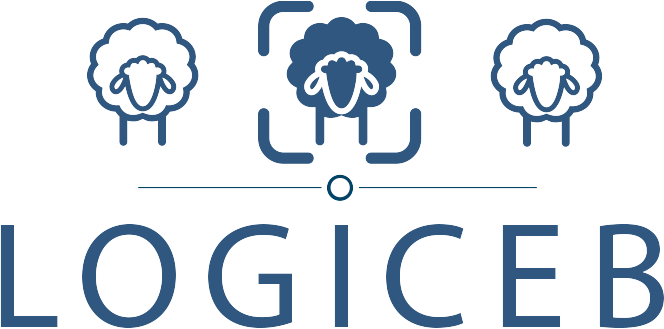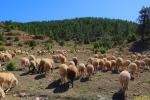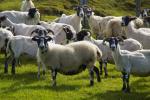
LOGICEB Operational Group: Automated individual identification and logistic regression for reducing mortality in lamb feedlots
- Type Operational group
- Status In progress
- Execution 2024 -2025
- Assigned Budget 283.527,00 €
- Scope Autonómico
- Autonomous community Andalucía
- Project website GO LOGICEB
Feedlots will be equipped with individualized identification and monitoring systems, enabling data collection with reduced effort. Computer tools based on epidemiological data will be developed to determine whether the onset of pathological processes originates in feedlots or in previous production phases.
These tools will allow the responsibility of the parties involved to be determined. Specific health protocols will be designed, including etiological, nutritional, management, facility, and source factors that have been shown to be associated with morbidity and mortality caused by various agents, with special attention to respiratory disease. Training programs will be established for feedlot personnel to adapt them to the new technology and management protocols, emphasizing their understanding of the rationale and benefits of the proposed actions. Improve the profitability of sheep fattening in Andalusia by increasing process efficiency and reducing losses due to health problems.
All of this will ultimately result in a substantial improvement in the health and economics of feedlots, with fewer cases, lower mortality, and without requiring a greater effort from staff. Degree of innovation of the proposal - Innovation in identification: Identification, which has usually been carried out at the collective level, according to the farms of origin, will now be carried out individually, with all the advantages mentioned. To this must be added the element of technicalization, based on the use of a barcode reader to replace the usual method of physically writing it down on paper. This method saves work and enables the immediate arrival of the reading data to the database, which can be processed remotely.
Furthermore, the fact that each reader is linked to a specific event (entry into the feedlot, entry into the infirmary, animal death) allows for immediate modification of the dependent variables, resulting in dynamic models. 2) Innovation in the methodology for analyzing the data obtained: Through the proposed system, the routine use of a powerful statistical tool, such as logistic regression, which is commonly used in research, will be implemented for decision-making at the feedlot level. This tool makes it possible to identify factors associated with morbidity and mortality, enabling the design and implementation of tailored control plans. It also makes it possible to determine whether the factors are acting at the feedlot level or in previous phases of the production system, which is very useful for determining responsibility.
- Identification of risk factors.
- Establishment of the initial health situation in the feedlots.
- Automation of the collection of dependent variables.
- Collection of independent variables.
- Training.
- Determination of epidemiological models using logistic regression.
- Evaluation of specific control measures to be included in control plans.
- Development of a database and application of statistical analysis.
- Evaluation of the economic impact of the measures adopted.
- Determination of additional benefits.
- Coordination and writing of reports.
- Dissemination and dissemination.
There is currently widespread concern in Andalusian feedlots due to the high percentage of lamb losses. Several factors have contributed to the increase in mortality, although the most notable are the policies restricting the use of antimicrobials, which have been one of the key elements in controlling infectious processes, by far the most frequent and important, due to their severity, of all those affecting this production system.
Within infectious etiologies, respiratory illnesses are the most common cause of illness and death. Last year's rise in lamb prices significantly increased the economic value of mortality losses. While it is possible to refer to the literature to identify the causes and factors associated with mortality, it is not always useful because in epidemiology, the factors involved often vary from case to case.
Therefore, studies conducted on each affected farm provide better-quality information. However, these types of studies require updated data and the participation of epidemiologists, as statistical analysis and interpretation of the results are highly complex.
The main objective is to develop a decision-making system, based on automated data collection and the identification of risk factors, to reduce the incidence of disease and mortality in lamb feedlots in Andalusia.
Technological tools validated under real-life conditions will be implemented for more eco-efficient management of Andalusian sheep feedlots. Once these factors are identified, specific management protocols will be designed to prevent the onset of infectious processes.
- Coordinator/entity name: University of Córdoba (Alfonso Carbonero)
- Postal address: Rabanales University Campus, Madrid-Cordoba Highway, Km. 396, Cordoba
- Coordinator/entity email: espargen@hotmail.com
- Telephone: 957211067
Royal Decree 728/2007, of June 13, establishing and regulating the General Register of Livestock Movements and the General Register of Individual Animal Identification, has been amended to include the recording of death data for sheep and goats and to include species not included in the General Register of Livestock Farms.
This latest regulation specifies that sheep must be individually identified by ear tag or rumen bolus, and the deaths of each individual must also be recorded. The electronic identification systems we propose implementing in this Operational Group are not officially regulated, so they would be additional to the mandatory identification systems regulated in the aforementioned Royal Decree.
- Universidad de Córdoba (Alfonso Carbonero)
- Cooperativas Agro-alimentarias de Andalucía (cooperativas@agroalimentarias-andalucia.coop)
- CEIA3 (gerente@ceia3.es)
- Dehesas Cordobesas S.C.A (ma.pereafranco@gmail.com)
- Cosevilla S.C.A (veterinario@corsevilla.es)
- Comercializadora Segureña S.C.A (pepepuntas@ancos.org)
- Universidad de Córdoba (Alfonso Carbonero)
- News
- Video channel of the Operational Group
- Facebook Account of the Operational Group
- Account of the Operating Group in X
- Operational Group Instagram Account
- UCO website
- CEIA3 Web
- Website of the Agro-Food Cooperatives of Andalusia
- Dehesas Cordobesas SCA Website
- CorSevilla Website
- Segureña SCA Marketing Website






